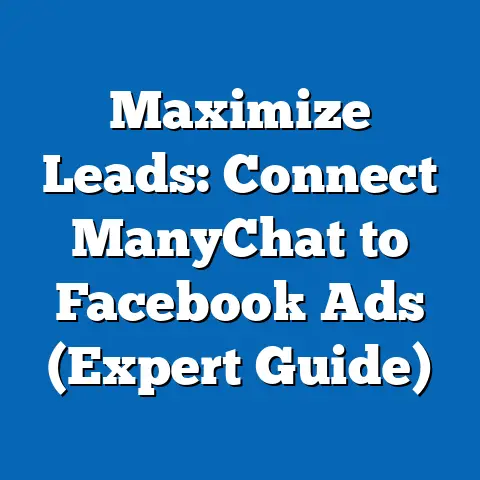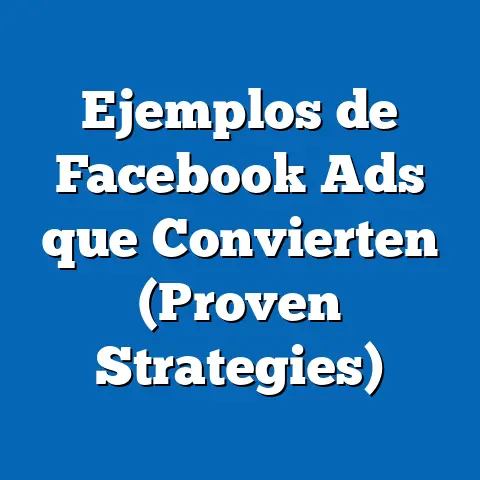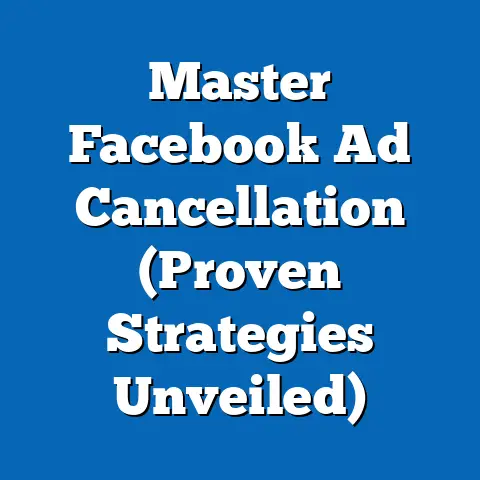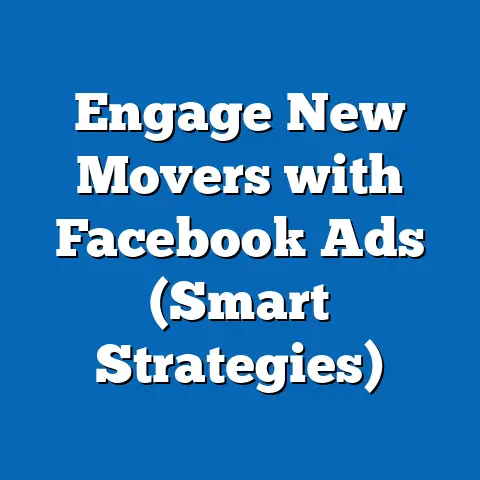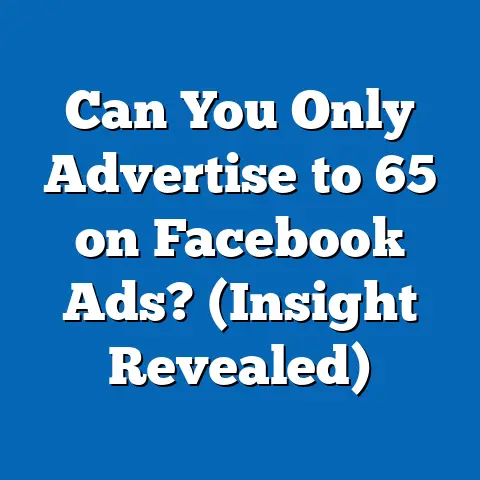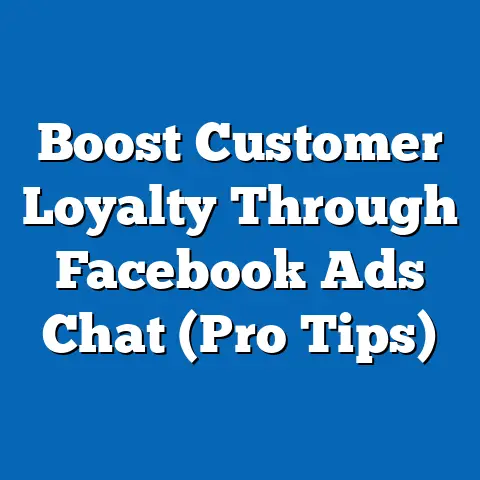Craft Perfect Facebook Ads (Proven Structure Secrets)
“The best advertising is done by satisfied customers.” – Philip Kotler. This quote, attributed to marketing guru Philip Kotler, highlights a fundamental truth about advertising: authenticity and resonance are key. In today’s digital age, where attention spans are fleeting and consumers are bombarded with ads at every turn, creating Facebook ads that truly connect with your audience is more critical than ever. Understanding the structure of successful Facebook ads is the first step toward crafting campaigns that not only grab attention but also drive meaningful engagement and conversions.
I remember when I first started running Facebook ads. I was so focused on the product I was selling that I completely neglected to think about the audience I was trying to reach. My ads were generic, boring, and ultimately, ineffective. It wasn’t until I started studying the anatomy of successful ads and experimenting with different structures that I began to see real results. In this article, I’ll share the secrets I’ve learned over the years, so you can create Facebook ads that truly resonate with your target audience and achieve your marketing goals.
Understanding the Facebook Advertising Landscape
Facebook, with its billions of active users, remains a dominant force in the advertising world. As of Q4 2023, Facebook reported over 3 billion monthly active users, making it an invaluable platform for businesses of all sizes to reach a vast and diverse audience. This massive reach, combined with sophisticated targeting capabilities, makes Facebook advertising a powerful tool for driving brand awareness, generating leads, and boosting sales.
The landscape of Facebook advertising has evolved significantly since its inception. Initially, ads were simple text-based messages, but today, they encompass a wide range of formats, including image ads, video ads, carousel ads, and collection ads. This evolution reflects the changing preferences of users and the increasing sophistication of the platform’s advertising algorithms.
The relevance of Facebook ads in today’s digital marketing strategies cannot be overstated. According to Statista, digital advertising spending worldwide is projected to reach over $600 billion in 2024, with social media advertising accounting for a significant portion of this figure. Facebook’s ability to deliver targeted ads to specific demographics, interests, and behaviors makes it a highly effective platform for businesses looking to maximize their return on investment (ROI).
However, the effectiveness of Facebook advertising hinges on the quality and structure of the ads themselves. Ads that are poorly designed, poorly targeted, or irrelevant to the audience are likely to be ignored or even negatively received. This is why understanding the anatomy of a perfect Facebook ad and mastering proven ad structures is crucial for success.
Key Takeaway: Facebook remains a powerful advertising platform with immense reach and sophisticated targeting capabilities. However, success depends on creating well-structured ads that resonate with the target audience.
The Anatomy of a Perfect Facebook Ad
A perfect Facebook ad is more than just a pretty picture and some catchy text. It’s a carefully crafted message that combines compelling visuals, persuasive copy, and precise targeting to capture the attention of the right audience and drive the desired action. Let’s break down the essential components of a high-performing Facebook ad:
Headline: The Hook That Grabs Attention
The headline is the first thing people see, and it’s your opportunity to make a strong first impression. A captivating headline can pique curiosity, highlight a benefit, or pose a question that compels users to learn more.
- Why it matters: In a crowded newsfeed, a strong headline is essential for standing out and grabbing attention.
- Examples of effective headlines:
- “Unlock Your Dream Home with Our Exclusive Mortgage Rates”
- “Tired of Sleepless Nights? Discover the Secret to Better Sleep”
- “Learn a New Language in 30 Days – Guaranteed!”
- My experience: I’ve found that headlines that use numbers or strong emotional words tend to perform best. For example, “5 Proven Strategies to Boost Your Facebook Ad ROI” outperformed a similar headline without the number.
- “Unlock Your Dream Home with Our Exclusive Mortgage Rates”
- “Tired of Sleepless Nights? Discover the Secret to Better Sleep”
- “Learn a New Language in 30 Days – Guaranteed!”
Visual Content: The Image That Tells a Story
Visual content, whether it’s an image or a video, plays a crucial role in capturing attention and conveying your message. High-quality visuals can evoke emotions, showcase your product, or demonstrate a benefit.
- Why it matters: Visuals are processed much faster than text, making them an effective way to grab attention and communicate your message quickly.
- Tips on selecting the right visuals:
- Use high-resolution images or videos that are relevant to your ad message.
- Choose visuals that evoke positive emotions or create a sense of curiosity.
- Test different visuals to see what resonates best with your audience.
- My experience: I once ran an ad campaign for a local bakery, and the ads featuring mouth-watering photos of their pastries consistently outperformed ads with generic stock photos.
- Use high-resolution images or videos that are relevant to your ad message.
- Choose visuals that evoke positive emotions or create a sense of curiosity.
- Test different visuals to see what resonates best with your audience.
Ad Copy: The Words That Persuade
The ad copy is where you tell your story, highlight the benefits of your product or service, and persuade users to take action. Effective ad copy is clear, concise, and compelling, and it always includes a strong call to action (CTA).
- Why it matters: The ad copy provides the context and information that users need to understand your offer and decide whether to take action.
- Essential components of persuasive ad copy:
- Clarity: Clearly state what you’re offering and what users will get if they take action.
- Brevity: Keep your copy concise and to the point, focusing on the most important information.
- Compelling Call to Action (CTA): Tell users exactly what you want them to do, such as “Shop Now,” “Learn More,” or “Sign Up.”
- Examples of high-converting ad copy:
- “Get 20% off your first order when you sign up for our newsletter! Shop now and discover the latest trends.”
- “Transform your body in just 30 days with our proven fitness program. Learn more and start your free trial today!”
- My experience: I’ve found that using strong verbs and creating a sense of urgency in my CTAs can significantly improve conversion rates. For example, “Claim Your Discount Now!” outperformed “Learn More” in one of my recent campaigns.
- Clarity: Clearly state what you’re offering and what users will get if they take action.
- Brevity: Keep your copy concise and to the point, focusing on the most important information.
- Compelling Call to Action (CTA): Tell users exactly what you want them to do, such as “Shop Now,” “Learn More,” or “Sign Up.”
- “Get 20% off your first order when you sign up for our newsletter! Shop now and discover the latest trends.”
- “Transform your body in just 30 days with our proven fitness program. Learn more and start your free trial today!”
Targeting: Reaching the Right People
Even the most perfectly crafted ad will fail if it’s not shown to the right audience. Facebook’s targeting options allow you to narrow your audience based on demographics, interests, behaviors, and more, ensuring that your ads are seen by the people who are most likely to be interested in your offer.
- Why it matters: Targeting ensures that your ads are seen by the people who are most likely to be interested in your offer, maximizing your ROI and minimizing wasted ad spend.
- How to identify and target the right audience:
- Define your ideal customer: Create a detailed profile of your ideal customer, including their demographics, interests, behaviors, and pain points.
- Use Facebook’s audience insights tool: This tool provides valuable data about your target audience, including their demographics, interests, and online behavior.
- Experiment with different targeting options: Test different targeting options to see what works best for your business.
- My experience: I once ran an ad campaign for a local yoga studio, and I initially targeted a broad audience of people interested in health and fitness. However, when I narrowed my targeting to people interested in yoga, meditation, and mindfulness, my conversion rates skyrocketed.
- Define your ideal customer: Create a detailed profile of your ideal customer, including their demographics, interests, behaviors, and pain points.
- Use Facebook’s audience insights tool: This tool provides valuable data about your target audience, including their demographics, interests, and online behavior.
- Experiment with different targeting options: Test different targeting options to see what works best for your business.
Key Takeaway: A perfect Facebook ad combines a captivating headline, compelling visuals, persuasive copy, and precise targeting to capture attention and drive action.
Proven Structures for High-Performing Facebook Ads
While the anatomy of a perfect Facebook ad provides the building blocks, understanding proven ad structures is like having a blueprint for success. These structures provide a framework for organizing your message and presenting it in a way that resonates with your target audience. Here are three proven structures that I’ve found to be particularly effective:
AIDA Model (Attention, Interest, Desire, Action):
The AIDA model is a classic marketing framework that has been used for decades to guide the creation of persuasive marketing messages. It stands for Attention, Interest, Desire, and Action, and it represents the four stages that a customer goes through when making a purchase decision.
- Attention: Grab the audience’s attention with a compelling headline or visual.
- Interest: Generate interest by highlighting the benefits of your product or service.
- Desire: Create desire by showcasing the value of your offer and addressing any pain points.
- Action: Prompt the audience to take action with a clear and compelling call to action.
Step-by-step guide on creating an ad using the AIDA model:
- Attention: Start with a headline that grabs attention and piques curiosity. For example, “Are You Tired of Feeling Tired?”
- Interest: Highlight the benefits of your product or service and explain how it can solve their problem. For example, “Our Energy Boost Supplement Can Help You Feel More Alert and Productive All Day Long.”
- Desire: Create desire by showcasing the value of your offer and addressing any pain points. For example, “Imagine Waking Up Feeling Refreshed and Ready to Tackle the Day. Our Supplement is Made with All-Natural Ingredients and Has Been Clinically Proven to Boost Energy Levels.”
- Action: Prompt the audience to take action with a clear and compelling call to action. For example, “Try Our Energy Boost Supplement Today and Experience the Difference! Shop Now.”
Example:
- Problem: Identify the audience’s problem or pain point.
- Agitation: Agitate the problem by highlighting the negative consequences of not solving it.
- Solution: Present your product or service as the solution to their problem.
Case study or example where this structure significantly improved ad performance:
I once ran an ad campaign for a company that sold software for managing social media accounts. Initially, my ads focused on the features of the software, but they weren’t performing well. I then decided to try the PAS framework, and the results were dramatic.
- Problem: “Are you spending too much time managing your social media accounts?”
- Agitation: “Imagine how much time and money you’re wasting by manually posting updates, tracking analytics, and engaging with your audience. You’re missing out on valuable opportunities to grow your business.”
- Solution: “Our Social Media Management Software Can Automate Your Tasks, Track Your Results, and Help You Grow Your Business. Try Our Free Trial Today!”
The PAS framework resonated with the audience because it directly addressed their pain points and offered a clear solution. As a result, my click-through rates and conversion rates increased significantly.
The 4C’s Framework (Clear, Concise, Compelling, and Credible):
The 4C’s framework is a simple but effective way to ensure that your ads are high-quality and resonate with your target audience. It stands for Clear, Concise, Compelling, and Credible.
- Clear: Your ad message should be easy to understand and free of jargon.
- Concise: Your ad copy should be to the point and focus on the most important information.
- Compelling: Your ad should be engaging and persuasive, capturing the audience’s attention and motivating them to take action.
- Credible: Your ad should be believable and trustworthy, building confidence in your brand and your offer.
Practical tips on ensuring each component of the 4C’s is addressed in ad creation:
- Clear: Use simple language and avoid technical terms. Focus on the benefits of your product or service rather than the features.
- Concise: Keep your ad copy short and to the point. Use bullet points or short paragraphs to break up the text and make it easier to read.
- Compelling: Use strong verbs and create a sense of urgency in your CTAs. Highlight the value of your offer and address any pain points.
- Credible: Use testimonials, case studies, or social proof to build trust and credibility. Back up your claims with data and evidence.
Key Takeaway: Proven ad structures like AIDA, PAS, and the 4C’s provide a framework for organizing your message and presenting it in a way that resonates with your target audience.
Testing and Optimization
Creating a perfect Facebook ad is not a one-time event. It’s an ongoing process of testing, analyzing, and optimizing to improve performance and maximize ROI. A/B testing is a crucial tool for determining the effectiveness of different ad components, such as headlines, visuals, and ad copy.
Importance of A/B testing:
A/B testing allows you to compare two versions of an ad (A and B) to see which one performs better. By testing different elements, you can identify what resonates with your audience and optimize your ads for maximum impact.
Key metrics to track for optimization:
- Click-Through Rate (CTR): The percentage of people who see your ad and click on it.
- Conversion Rate: The percentage of people who click on your ad and complete the desired action, such as making a purchase or signing up for a newsletter.
- Cost Per Click (CPC): The average cost you pay each time someone clicks on your ad.
- Cost Per Conversion (CPC): The average cost you pay for each conversion.
- Return on Ad Spend (ROAS): The amount of revenue you generate for every dollar you spend on advertising.
Strategies for continuous improvement based on data analytics:
- Identify your key performance indicators (KPIs): Determine which metrics are most important for your business goals.
- Track your KPIs regularly: Monitor your KPIs to identify trends and patterns.
- Experiment with different ad components: Test different headlines, visuals, ad copy, and targeting options to see what works best.
- Analyze your results: Use data analytics to understand what’s driving your results and identify areas for improvement.
- Implement your findings: Apply your learnings to optimize your ads and improve your performance.
My experience: I once ran an A/B test where I compared two different headlines for the same ad. Headline A was a simple statement of fact, while Headline B was a question that piqued curiosity. Headline B outperformed Headline A by a wide margin, demonstrating the power of curiosity in driving clicks.
Key Takeaway: Testing and optimization are crucial for maximizing the performance of your Facebook ads. Use A/B testing to identify what resonates with your audience and continuously improve your ads based on data analytics.
Common Mistakes to Avoid
Even with a solid understanding of the anatomy of a perfect Facebook ad and proven ad structures, it’s easy to fall into common pitfalls that can sabotage your results. Here are some frequent mistakes that marketers encounter when creating Facebook ads:
- Poor Targeting: Targeting the wrong audience is one of the most common mistakes that marketers make. This can result in wasted ad spend and low conversion rates.
- Irrelevant Ads: Creating ads that are not relevant to the target audience is another common mistake. This can lead to low engagement and negative feedback.
- Weak Headlines: Using weak or uninspired headlines can cause your ads to get lost in the newsfeed.
- Low-Quality Visuals: Using low-resolution images or videos can damage your brand and make your ads look unprofessional.
- Unclear Call to Action: Failing to include a clear and compelling call to action can leave users confused about what you want them to do.
- Ignoring Mobile Users: Many Facebook users access the platform on their mobile devices. Failing to optimize your ads for mobile can result in a poor user experience and low conversion rates.
How to avoid these mistakes by adhering to the proven structures discussed earlier:
- Targeting: Use Facebook’s audience insights tool to identify and target the right audience for your ads.
- Relevance: Create ads that are relevant to the interests and needs of your target audience.
- Headlines: Use strong, attention-grabbing headlines that pique curiosity and highlight the benefits of your offer.
- Visuals: Use high-quality images or videos that are relevant to your ad message and evoke positive emotions.
- Call to Action: Include a clear and compelling call to action that tells users exactly what you want them to do.
- Mobile Optimization: Optimize your ads for mobile devices by using responsive ad formats and ensuring that your landing pages are mobile-friendly.
Key Takeaway: Avoiding common mistakes is essential for maximizing the effectiveness of your Facebook ads. By adhering to the proven structures discussed earlier, you can create ads that resonate with your target audience and achieve your marketing goals.
Conclusion
Crafting perfect Facebook ads is a blend of art and science. It requires a deep understanding of your audience, a mastery of proven ad structures, and a commitment to continuous testing and optimization. By focusing on the anatomy of a perfect ad – the captivating headline, compelling visuals, persuasive copy, and precise targeting – and by leveraging frameworks like AIDA, PAS, and the 4C’s, you can create ads that not only attract attention but also drive conversions.
Remember, the key to success is to never stop learning and experimenting. The Facebook advertising landscape is constantly evolving, and what works today may not work tomorrow. Stay up-to-date with the latest trends and best practices, and always be willing to adapt your strategy based on data and feedback.
I hope this guide has provided you with the knowledge and inspiration you need to create Facebook ads that truly resonate with your target audience and achieve your marketing goals. Now it’s time to put these proven structures into practice and see the results for yourself.
Call to Action
Ready to take your Facebook advertising to the next level? Start implementing the strategies and structures discussed in this article today! Experiment with different headlines, visuals, and ad copy to see what resonates best with your audience. Don’t forget to track your results and optimize your ads for maximum impact.
I encourage you to share your experiences in the comments below or through social media engagement. Let’s learn from each other and create a community of successful Facebook advertisers! What are your favorite ad structures? What challenges have you faced, and how have you overcome them? Share your insights and let’s help each other succeed in the ever-evolving world of Facebook advertising.

